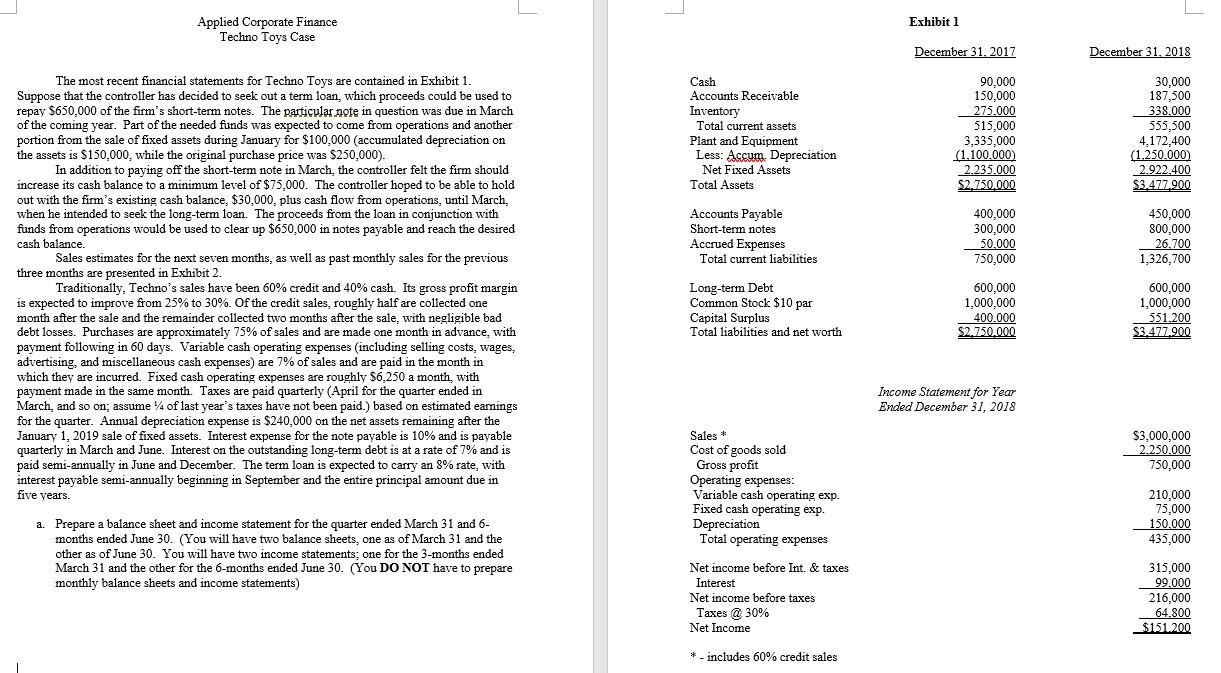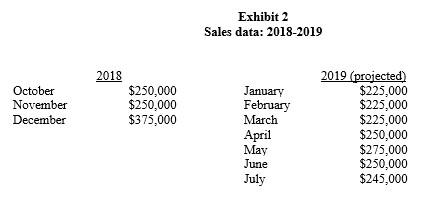

Exhibiti Applied Corporate Finance Techno Toys Case December 31, 2017 December 31, 2018 Cash Accounts Receivable Inventory Total current assets Plant and Equipment Less: Accum. Depreciation Net Fixed Assets Total Assets 90.000 150,000 275.000 515,000 3,335,000 (1.100.000 2.235,000 2.750.000 30,000 187,500 338.000 555,500 4,172.400 (1.250,000) 2.922.400 $3.477.900 Accounts Payable Short-term notes Accrued Expenses Total current liabilities 400,000 300,000 50.000 750,000 450,000 800,000 26.700 1,326,700 The most recent financial statements for Techno Toys are contained Exhibit 1. Suppose that the controller has decided to seek out a term loan, which proceeds could be used to repay $650,000 of the firm's short-term notes. The particular note in question was due in March of the coming year. Part of the needed funds was expected to come from operations and another portion from the sale of fixed assets during January for $100.000 (accumulated depreciation on the assets is $150,000, while the original purchase price was $250,000). In addition to paying off the short-term note in March, the controller felt the firm should increase its cash balance to a minimum level of $75,000. The controller hoped to be able to hold out with the firm's existing cash balance, $30,000, plus cash flow from operations, until March, when he intended to seek the long-term loan. The proceeds from the loan in conjunction with funds from operations would be used to clear up $650,000 in notes payable and reach the desired cash balance. Sales estimates for the next seven months, s well past monthly sales for the previous three months are presented Exhibit 2. Traditionally, Techno's sales have been 60% credit and 40% cash. Its gross profit margin is expected to improve from 25% to 30%. Of the credit sales, roughly half are collected one month after the sale and the remainder collected two months after the sale, with negligible bad debt losses. Purchases are approximately 75% of sales and are made one month in advance, with payment following in 60 days. Variable cash operating expenses (including selling costs, wages, advertising, and miscellaneous cash expenses) are 7% of sales and are paid in the month in which they are incurred. Fixed cash operating expenses are roughly 56,250 a month, with payment made in the same month. Taxes are paid quarterly (April for the quarter ended in March, and so on; assume 14 of last year's taxes have not been paid.) based on estimated earnings for the quarter. Annual depreciation expense is $240,000 on the net assets remaining after the January 1, 2019 sale of fixed assets. Interest expense for the note payable is 10% and is payable quarterly in March and June. Interest on the outstanding long-term debt is at a rate of 7% and is paid semi-annually in June and December. The term loan is expected to carry an 8% rate, with interest payable semi-annually beginning in September and the entire principal amount due in five years. Long-term Debt Common Stock $10 par Capital Surplus Total liabilities and net worth 600,000 1,000,000 400.000 $2.750.000 600,000 1,000,000 351.200 $3.477.900 Income Statement for Year Ended December 31, 2018 $3,000,000 2.250.000 750,000 Sales * Cost of goods sold Gross profit Operating expenses: Variable cash operating exp. Fixed cash operating exp. Depreciation Total operating expenses 210,000 75,000 150.000 435,000 a. Prepare a balance sheet and income statement for the quarter ended March 31 and 6- months ended June 30. (You will have two balance sheets, one as of March 31 and the other as of June 30. You will have two income statements; one for the 3-months ended March 31 and the other for the 6-months ended June 30. (You DO NOT have to prepare monthly balance sheets and income statements) Net income before Int. & taxes Interest Net income before taxes Taxes @ 30% Net Income 315,000 99.000 216,000 64.800 $151.200 * -includes 60% credit sales Exhibit 2 Sales data: 2018-2019 October November December 2018 $250,000 $250,000 $375,000 January February March April May June July 2019 (projected) $225,000 $225,000 $225,000 $250,000 $275,000 $250,000 $245,000 Exhibiti Applied Corporate Finance Techno Toys Case December 31, 2017 December 31, 2018 Cash Accounts Receivable Inventory Total current assets Plant and Equipment Less: Accum. Depreciation Net Fixed Assets Total Assets 90.000 150,000 275.000 515,000 3,335,000 (1.100.000 2.235,000 2.750.000 30,000 187,500 338.000 555,500 4,172.400 (1.250,000) 2.922.400 $3.477.900 Accounts Payable Short-term notes Accrued Expenses Total current liabilities 400,000 300,000 50.000 750,000 450,000 800,000 26.700 1,326,700 The most recent financial statements for Techno Toys are contained Exhibit 1. Suppose that the controller has decided to seek out a term loan, which proceeds could be used to repay $650,000 of the firm's short-term notes. The particular note in question was due in March of the coming year. Part of the needed funds was expected to come from operations and another portion from the sale of fixed assets during January for $100.000 (accumulated depreciation on the assets is $150,000, while the original purchase price was $250,000). In addition to paying off the short-term note in March, the controller felt the firm should increase its cash balance to a minimum level of $75,000. The controller hoped to be able to hold out with the firm's existing cash balance, $30,000, plus cash flow from operations, until March, when he intended to seek the long-term loan. The proceeds from the loan in conjunction with funds from operations would be used to clear up $650,000 in notes payable and reach the desired cash balance. Sales estimates for the next seven months, s well past monthly sales for the previous three months are presented Exhibit 2. Traditionally, Techno's sales have been 60% credit and 40% cash. Its gross profit margin is expected to improve from 25% to 30%. Of the credit sales, roughly half are collected one month after the sale and the remainder collected two months after the sale, with negligible bad debt losses. Purchases are approximately 75% of sales and are made one month in advance, with payment following in 60 days. Variable cash operating expenses (including selling costs, wages, advertising, and miscellaneous cash expenses) are 7% of sales and are paid in the month in which they are incurred. Fixed cash operating expenses are roughly 56,250 a month, with payment made in the same month. Taxes are paid quarterly (April for the quarter ended in March, and so on; assume 14 of last year's taxes have not been paid.) based on estimated earnings for the quarter. Annual depreciation expense is $240,000 on the net assets remaining after the January 1, 2019 sale of fixed assets. Interest expense for the note payable is 10% and is payable quarterly in March and June. Interest on the outstanding long-term debt is at a rate of 7% and is paid semi-annually in June and December. The term loan is expected to carry an 8% rate, with interest payable semi-annually beginning in September and the entire principal amount due in five years. Long-term Debt Common Stock $10 par Capital Surplus Total liabilities and net worth 600,000 1,000,000 400.000 $2.750.000 600,000 1,000,000 351.200 $3.477.900 Income Statement for Year Ended December 31, 2018 $3,000,000 2.250.000 750,000 Sales * Cost of goods sold Gross profit Operating expenses: Variable cash operating exp. Fixed cash operating exp. Depreciation Total operating expenses 210,000 75,000 150.000 435,000 a. Prepare a balance sheet and income statement for the quarter ended March 31 and 6- months ended June 30. (You will have two balance sheets, one as of March 31 and the other as of June 30. You will have two income statements; one for the 3-months ended March 31 and the other for the 6-months ended June 30. (You DO NOT have to prepare monthly balance sheets and income statements) Net income before Int. & taxes Interest Net income before taxes Taxes @ 30% Net Income 315,000 99.000 216,000 64.800 $151.200 * -includes 60% credit sales Exhibit 2 Sales data: 2018-2019 October November December 2018 $250,000 $250,000 $375,000 January February March April May June July 2019 (projected) $225,000 $225,000 $225,000 $250,000 $275,000 $250,000 $245,000








